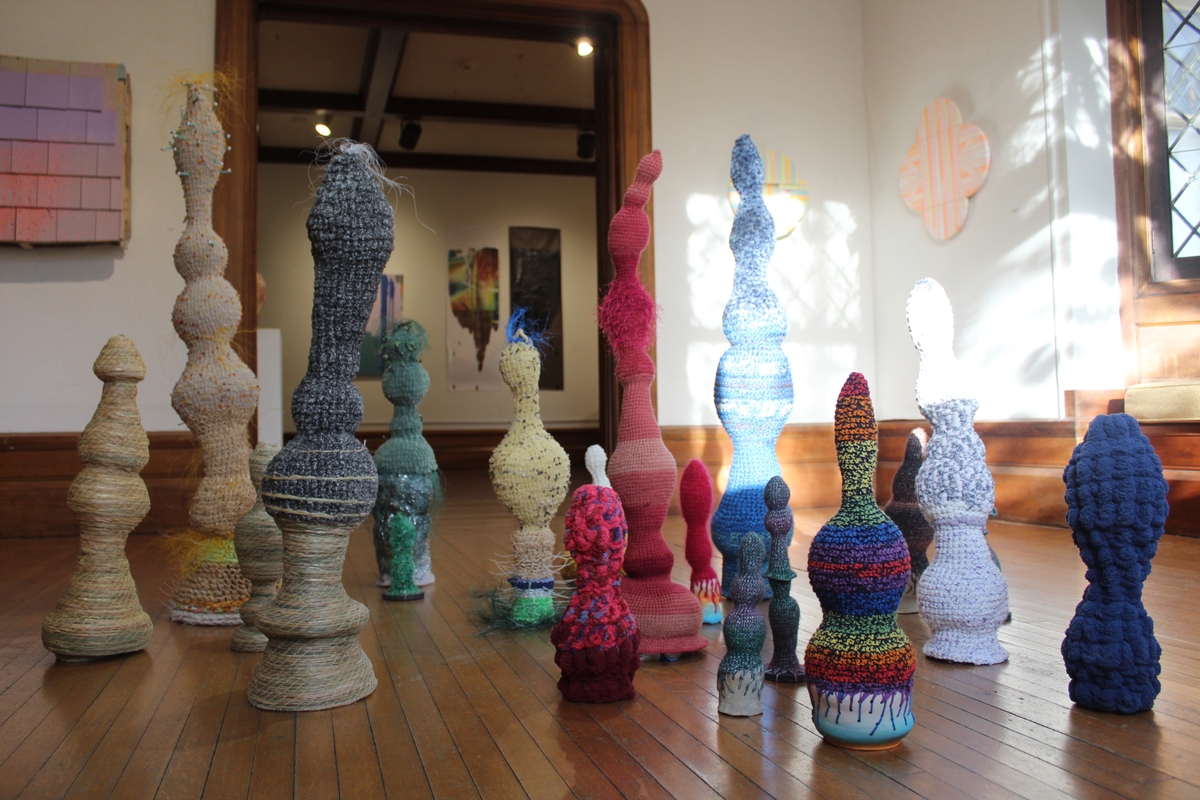
Hyunsuk Erickson
Thingumabob Tribe #3
Hyunsuk Erickson’s Thingumabob Tribe #3 spreads out across one of the first-floor galleries of the Ely Center of Contemporary Art. Their sinuous shapes and bright colors might carry, for some viewers, suggestions of meaning. They could be seen as chess pieces, or as rock formations on an alien planet. Or perhaps they’re microscopic shapes brought to the human scale. On the other hand, are they really asking to be understood, to be perceived in that way? They can be taken as is, simply as shapes, forms, colors. Or anything in between, an apprehension of form, the content arising in the viewer.
Erickson’s piece is part of “A Way of Seeing Everything and Nothing,” a group show of 23 artists curated by Suzan Shutan & Howard el-Yasin of SomethingProjects, running now at the Ely Center of Contemporary Art, at 51 Trumbull St., through Jan. 14.
“In the book Ways of Seeing by John Berger, he suggests that we each see thing in a way no one has before. By doing so, we discover something about ourselves and the world we live in,” the curators write in an accompanying statement. “If nothingness is matter and energy, then it includes everything that exists within that nothingness. Can we see everything and nothing simultaneously? In traditional Chinese and Japanese art, the use of empty space or large areas left blank/unpainted are understood as information and considered a vital part of the artwork and composition.
“Our perception of realities are sensations that help us navigate the world, while our surroundings and our world is defined by the space we take up in it. The concept of there being emptiness and fullness in the same space is one that artists have long considered in their work. Abstraction refutes the Western world’s obsession with the visible and concrete. In nothingness a presence can be felt. In everything the material presence is seen.”
The show arose out of ECOCA inviting el-Yasin and Shutan to curate a show from the submissions from ECOCA’s annual open call for artwork. The curators found a lot of strong work to choose, and landed on the theme of abstraction to organize their selections. From this, they included the work of 23 artists from New Haven, elsewhere in Connecticut, and out of state, including New York, Pennsylvania, and Virginia.
“The artists’ work selected for this exhibition reveals an aspect of autonomous inner essence of creation, as being everything and nothing, defining a way of seeing,” the curators conclude.

Serena Bocchino
Seeing Through Blue (Motion Series).
The curators’ focus on abstraction serves as a powerful organizing principle for navigating this varied show, finding a common thread through disparate works. Serena Bocchino’s Seeing Through Blue up close is among the most formless pieces in the show. It can seem like a sheer exploration of color. But step far back, and a sense of pattern emerges in the overall composition, with echoes of some of the paintings in Monet’s water lilies series, or from paintings in Chinese and Japanese traditions of small figures moving through a foggy landscape.

Cynthia Cooper
Orange Blossom (pink).
Cynthia Cooper, meanwhile, finds order and balance in geometry, made even more soothing by pastel oranges and pinks. Cooper’s title lets the viewer’s mind make the piece into a flower, but only barely, while the piece’s rounded petals and the light falling on them make the shadows it casts part of the art.

Yoko Iwanaga
Nostalgic Summer.
The title of Yoko Iwanaga’s Nostalgic Summer opens the door far enough to let the viewer into her riotous canvas. Where Bocchino’s and Cooper’s pieces were more purely abstract, Iwanaga’s painting features flashes of figures — people, animals, dolls, vehicles, buildings — that seem to form and melt in rapid succession. The nostalgia here isn’t for a summer of lazy afternoons in humid shade, but for a summer of perhaps frantic activity, full of fun and adventure. The haziness of the figures carries an implication about memory, too: that even as some of the specific events of the summer may be harder to recall, the feeling of freedom and abandonment remains as vivid as ever.

Patricia Carrigan
Listening Cap.
Patricia Carrigan’s Listening Cap likewise has a way of snapping into focus, as the rough shapes can be seen as sketching out a human head, just for a moment, before relaxing back into pure abstraction. Like many of the pieces in the show, Carrigan’s painting doesn’t ask to be comprehended so much as felt. With the title as a small clue, the piece gets a little synesthetic; it can be read as capturing the experience of taking in sounds, perhaps to the point where it’s a little disorienting. A cacophony of voices? Loud, aggressive music? Regardless of the specifics, it’s a painting we can hear.
“A Way of Seeing Everything and Nothing” runs at the Ely Center of Contemporary Art, 51 Trumbull St., through Jan. 14. Visit the gallery’s website for hours and more information.